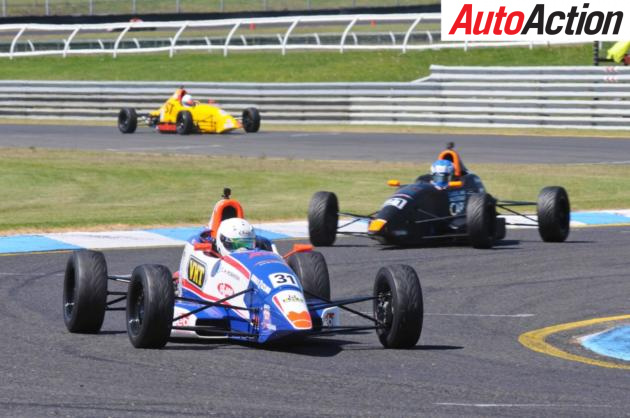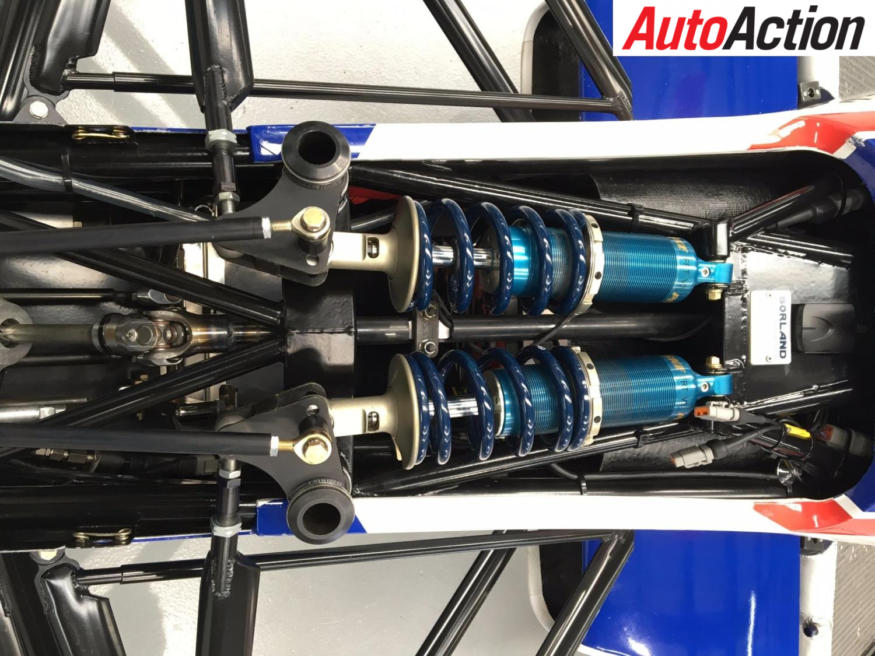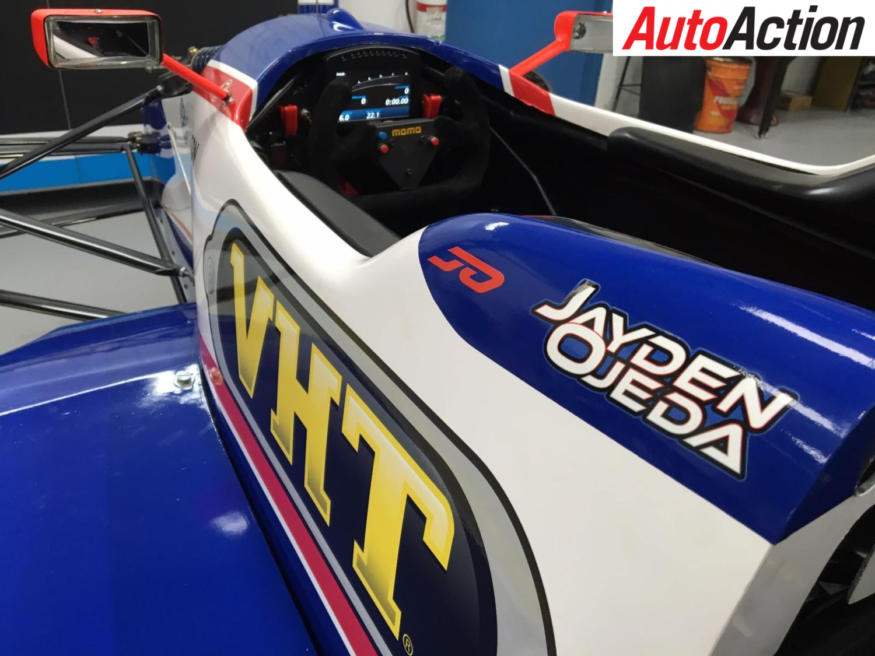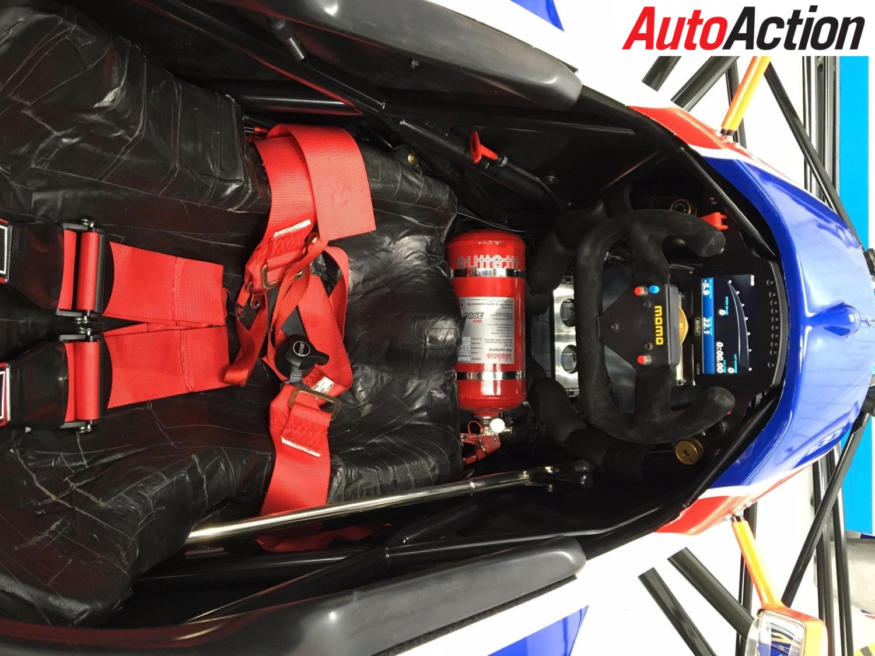UNDER THE SKIN: FORMULA FORD – AUSTRALIA, TO THE WORLD

Formula Ford continues to be a key stepping stone for the majority of Australia’s young up and comers as their first step into circuit racing. Auto action goes Under The Skin to find out what makes a Spectrum 015 tick.

Formula Ford continues to be a key stepping stone in Australian motorsport
FORMULA FORD has a strong history worldwide let alone in Australia and if you look up and down the Supercars grid, you will see quite a few Formula Ford champions including Craig Lowndes, Jason Bright, Garth Tander and more recently Nick Percat, Chaz Mostert and Cameron Waters.
Borland Racing Developments, founded by Michael Borland, has won four National Formula Ford titles in the last 20 years as well as overseas success in Britain, the US and Canada. Borland has also had a hand in the Daytona Coupe and Chris Lambden’s Formula Thunder 5000, but continues to frontrunner in Formula Ford with Liam McLellan taking Pole Position and Jayden Ojeda finishing a close second despite taking a debut double victory for the new Spectrum 015.
When asked about the differences between the new 015 and the previous 014 Borland explained that there wasn’t much difference as the team had carried out developments for the 015 last year.
It’s not a lot different to the 014 because a lot of the updates we put on the 014 through last year,” explained Borland.
“It has slightly different rear suspension geometry, it was meant to have a bit different bodywork on it but we ran out of time.

Under the skin of Jayden Ojeda’s Spectrum 015
Over the next few weeks we will revise some of the bodywork and we will revise little bits of the car and extra safety precautions for the drivers, such as a little more knee protection in the cockpit and things like that.”
The main development that the team has had to adjust to is the change from Avon to Yokohama tyres, which Borland sees as a massive advantage for the smaller teams and has seen the gap close at the front of the field.
Oh, and the tyres are around two thirds cheaper.
“I don’t think they are as hard to drive on, so that has narrowed the front of the field up as well. With the Avons you really had to be on top of the car and it moved around a lot in the back of the car.
“The people that were new to it struggled more and it was hard for the hobby drivers to get back in and on the pace with the younger kids, whereas the tyre is not as edgy anymore, so it has closed the gap a little bit and made it easier to drive. Obviously the best guy will still win but it has narrowed the field up a bit.”
Moving to Yokohama has seen the difference between a good and bad set up lessen making it more forgivable and a minimal adjustment required, which is making easier for the smaller father and son teams to get up to speed.
“One of the several good parts of the Yokohama tyre is that the operating window seems to be a lot bigger in it and you don’t have to be as precise with it,” explained Borland.
“I think that has helped the father and son teams get better results because you don’t have to have as much engineering input to getting the car right as you probably did on the Avon tyres.
“We changed the car for Sandown, the springs and sway bars, and then we leave the car with the same set up for every track that we run, we don’t change anything. We didn’t change a thing on Liam’s car all weekend. Even Jayden’s car, we were late finishing it, so he did four laps in anger in the car on Friday the week before at Winton and turned up at Sandown and moved a front sway bar about 10mm and that’s it.”

Front Shocks on the Spectrum 015 Formula Ford
One thing that has been constant for the last 15 years has been the steel tube, chrome-moly chassis, TIG welded that has seen very minor changes every time a new model Spectrum has been developed.
“We haven’t made a major change for a few years and 15 years ago we achieved the torsional rigidity that we needed out of the car,” continued Borland. “The cars are so softly sprung that we haven’t needed to go any further than that. You’re not always trying to make the chassis’ stiffer and stiffer, so we just stayed with that. We have lowered the centre of gravity as much as we can in the cars.”

Formula Ford’s Duratec Engine
Also a mainstay has been the Duratec engines, which has powered Formula Ford since 2006. Borland has been mightily impressed by the reliability. Each engine is built and maintained at the same place, so horsepower development is not an issue in the class.
“They’ve been ultra-reliable and we’re still running engines that we ran ten years ago,” Borland said. “We’ve had 15,000-18,000km running out of an engine between rebuilds and you send it back for, not because there is a performance drop off, but just for general maintenance. The Duratec has just been a fantastic engine to run with.”
Though when plans for the Duratec were first developed in 2005, there was an option to up the horsepower but Borland, through his experiences overseas, vetoed the idea.
“When we first came up with the concept of the Duratecs 10-12 years ago we could have gone more horsepower. In England, their Duratecs had more horsepower, they were around 160hp and they had the same basic engine but different camshafts and a bigger throttle body, but then the gearboxes and brakes were past their limits. We kept it at that level because we knew it would be reliable and easier on the brakes, easier on the rod ends, easier on the gearbox without massively increasing the running costs by running more horsepower.
“It’s a good balance, especially on the road-type tyres.”
The suspension set up on a Formula Ford comprises of independent front and rear suspension, which is push rod operated with a bell crank to the spring and damper. The suspension development Borland has undertaken has seen important gains over the last few years, though the team has used Penske shocks for 20 years.
“We have since the early 90’s run Penske and they’re really good. We keep the shocks simple for fashion reasons, we went to a more complicated shock three or four years ago, and going back to the 015 we have gone back to a simpler and lighter shock absorber that’s only a two-way adjustable shock. It doesn’t look as flash but it is only Formula Ford and clearly working with Jayden’s and Liam’s cars.”
A Hewland four-speed, H-Pattern gearbox sends the power through the rear wheels, but unfortunately due to the move away to sequential gearboxes these types of gearboxes have reduced in demand and have become extremely expensive as Borland explained.
It’s the same gearbox that originally came out 1989 and unfortunately now they’ve become really expensive now which is a shame as the class starts to grow back in Australia again,” rued Borland.
“You are looking at $15-$16,000 to buy a new gearbox, which is horrendous to pay. It represents 20-25 percent of the value of the car and they’re not selling as more because H-Pattern four-Speed gearboxes aren’t that popular around the world anymore.”
But could Formula Ford go sequential? Borland is unsure of the ramifications of such a decision.
“It’s hard to know if you changed anything what you’d go to that wasn’t detrimental,” said Borland. “At the moment everyone else has something similar in the car.
“I don’t know,” Borland continued.
“I suppose it has to be looked at some stage of the game if these continue to be hard to get and if Formula Ford starts to build up again and you need to buy gearboxes, then we’ll have to start looking at something, but whatever you do it’s going to come with a lot of pain.
“They do a JFR gearbox that bolts straight on with the same bolt pattern but its 15kg heavier and the rotating mass is heavier. It’s a six-speed sequential gearbox but you can always lock two gears out, but it’s a lot heavier, so whether that’s a disadvantage or seen as a disadvantage I don’t know.”
Downforce is outlawed in Formula Ford by Borland’s crew has worked hard on designing the most aero-efficient bodywork, while also looking to remove the amount of tow that their opponents gain. This is crucial, as we all know that the tow is an important part of Formula Ford racing and the results have proved to be beneficial.
“For us, we just try and reduce the drag as much as we can and we spend a bit of time doing coast-down testing, which I’ve found to be the most accurate and cost effective way to do that,” enthused Borland.
“One of the other big things we focus on is not giving off as bigger tow to the car behind and that’s one of the comments people make about our cars. We send our guys behind a Mygale because you get a much better tow behind a Mygale than their own teammates. We work hard on that part of it.”
Not only has the move to Yokohama made it more accessible but the way the Formula Ford National Series has moved to state based competition, forced or not, has made it even more possible for karters to step up to the national series. For as low as $40,000 you could be on the grid if you spin the spanners yourself, but if you want the full service and support from Borland’s expect to pay $120,000. This is compared to just over $200,000 for the final season that Formula Ford supported Supercars.
Plus, Adam Macrow, Spectrum’s first Formula Ford champion, now coaches the likes of Ojeda and McLellan and using GoPros, writes detailed reports and debriefs with the drivers after each weekend.
Borland hopes to head overseas this year to participate in the Canadian Formula 1 Grand Prix support races and the Walter Hayes Trophy for Kent Class cars. The versatility of the various Spectrum models has seen them compete worldwide with different engine and tyre packages successfully without need for a significant change.
“We can run a huge number of classes around the world with the same springs, same shocks, and same sway bars,” affirmed Borland.
“Our same set up on the cars will run at the front in the Walter Hayes Trophy with a Kent engine and on Avon Tyres in England. We won in England when we went there with John Martin and we won a lot of races with the Dunlop Slick tyres, in America we won the championship on Hoosier tyres with the Honda engine in it and in Canada on road radials with the Honda engine.”
When the Formula Ford Association was deciding whether to run on slick tyres or road radials, Borland used his experience from North America to decipher which option was the right way to go, ultimately deciding to go with the much cheaper road radials.
“The biggest thing we learnt from overseas was we were thinking about ramping it up and moving to a slick tyre,” explained Borland.
“In America we were running a slick tyre and you’d put six tyres on Saturday and Sunday, four tyres on Friday. In Canada, they put three sets on for the year at $700 a set, so one bill was $2100 and the other bill was $3000 a meeting.”

Brendon Jones running in the older Formula Ford Kent class
THE ORIGINAL CLASS
THE KENT engine is still a part of the National Formula Ford Series, but they run in their own class thanks to the Duratec engine boasting a 25hp advantage. Brendan Jones is a multiple Kent Class champion and believes the Duratec cars are harder to drive than his Kent Class Spectrum.
“It all happens a lot quicker; they get the power down a lot quicker, as far as the chassis is concerned the chassis’ are identical and the car that I drive can have a Kent engine or a Duratec engine,” explained Jones.
“They are a little bit harder on components, certainly on gearbox and clutch, but to the untrained you can look at them and they’re identical. I think you have to drive them a little bit harder than the Kent car.”
Though Jones is pleased with how the class is going, he would like to see a couple of changes that would modernise and improve the reliability of the Kent engine.
“I’m happy with it. There are a couple of little things to bring it in to the 21st century as far as some electronic ignition and to give some longevity a forged piston and a better conrod. We’ve got a steel crank now so the two components that can be bolted onto that might get you some longevity in the engine. Obviously valves and springs are still an issue when the seat is concerned, but it’s still cost effective motorsport.”
According to Jones the Kent Class is an ideal introduction into the Formula Ford class.
“The Kent Class is affordable, they’re great things to drive, although the numbers have dropped off over the last few years, it’s still a very competitive class and you get a very good bunch of guys.”

The cockpit of Jayden Ojeda’s Spectrum 015
HOW DO THEY DRIVE?
JAYDEN OJEDA took two race wins in the Spectrum 015s debut at round one of the National Formula Ford Series at Sandown. Ojeda placed fourth in last year’s title with two wins and nine podiums, but how was the transition from Karts to a Formula Ford? Ojeda explains.
“The leap from Go Karts to Formula Ford has taken a lot of time. Driving Technique is a lot different and you’re a lot my reliant on the Go Kart, whereas with formula Ford you have to have quite a bit of input from behind the wheel. Formula Ford is a bit of a steep step to climb, but once you get the hang of it you can really start to push yourself and get a nice reward from it with fastest laps and victories.”
“In Formula Ford you have to set-up the gear ratio, spring rates, suspension, the way the car rakes, pitches. There is so much to think about while you’re driving it. Weight transaction is quite a big one, which I didn’t quite understand when I jumped out of Karts. The way the car transacts and different kinds of weight transactions by the way you’re putting the input in and input of brakes. They’re a tricky little thing to drive, but rewarding when you get it right.”

Behind the wheel of Jayden Ojeda’s Spectrum 015
After Auto Action’s latest Under the Skin feature? Pick up the latest copy of magazine, in stores every second Thursday. Also follow us on social media Facebook, Twitter and Instagram for all the latest news.


